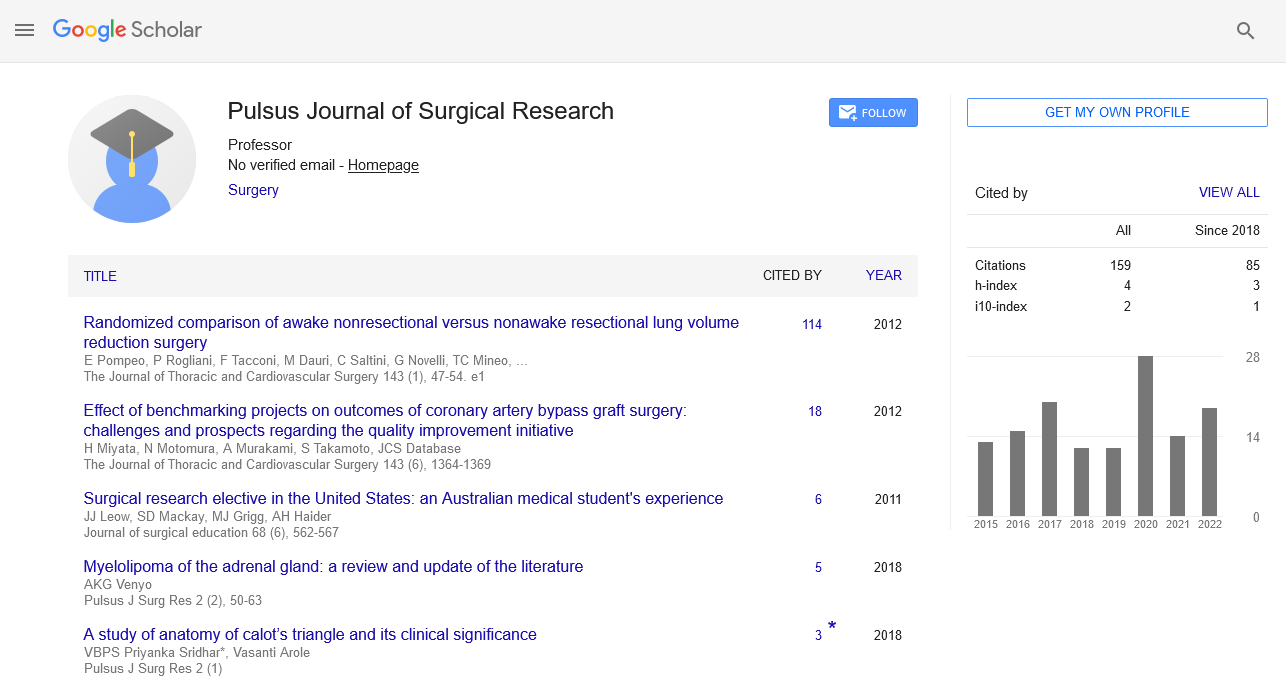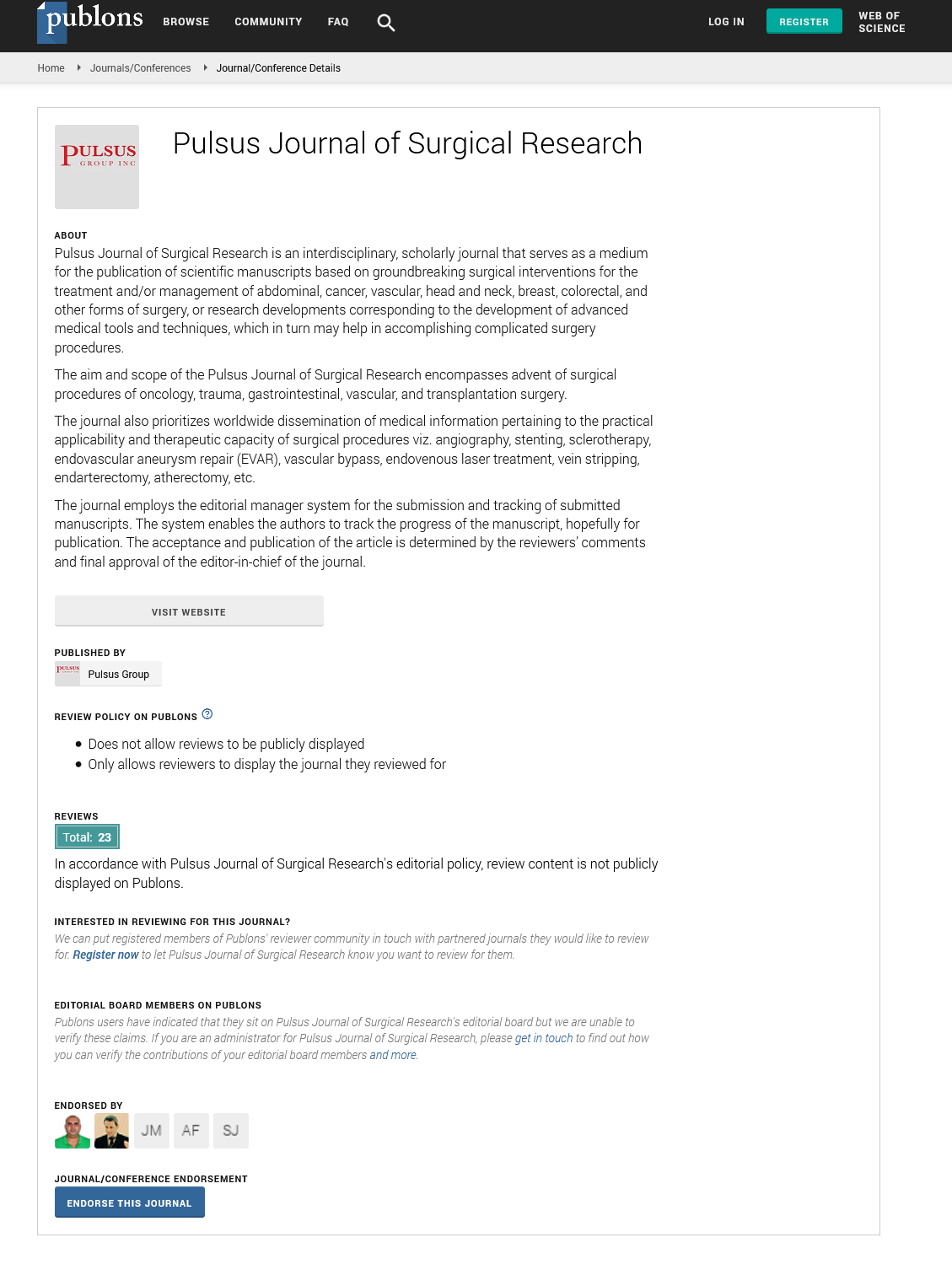Incidental finding of Gastrointestinal Stromal Tumors (GISTs) during Laparoscopic Sleeve Gastrectomy
Received: 10-Oct-2018 Accepted Date: Jan 03, 2019; Published: 15-Jan-2019
Citation: Sawalmeh H, Makhdoom M, Khammas A et al. Incidental finding of Gastrointestinal Stromal Tumors (GISTs) during Laparoscopic Sleeve Gastrectomy: A case report and literature review. Pulsus J Surg Res. 2019;3(1):87-89.
This open-access article is distributed under the terms of the Creative Commons Attribution Non-Commercial License (CC BY-NC) (http://creativecommons.org/licenses/by-nc/4.0/), which permits reuse, distribution and reproduction of the article, provided that the original work is properly cited and the reuse is restricted to noncommercial purposes. For commercial reuse, contact reprints@pulsus.com
Abstract
Gastrointestinal stromal tumors (GISTs) are rare stromal tumors found throughout the GI tract, but most commonly located in the stomach (mainly fundus and cardia) (50%), small bowel (25%) and less common in the colon (10 %), omentum/mesentery (7%), and esophagus (5%). Although the true incidence of GISTs is unknown, some reports have stated it to be about 0.68/100,000. They arise from the interstitial cells of Cajal, an intestinal pacemaker cell with characteristics of both neural and smooth muscle differentiation and are distinct from leiomyoma and leiomyosarcoma, which arise from smooth muscle. Immunohistochemical analysis demonstrates that nearly all GISTs express c-KIT protein (CD117) (95%), protein kinase C theta (80%) and CD34 (60-70%), and smooth muscle actin (30-40%) ; almost all smooth muscle tumours express actin and desmin. These markers can often be detected by specimens obtained by fine needle aspiration. This differentiation is crucial given that GISTs have a more aggressive clinical course when compared with other GI mesenchymal tumors, Gross differentiation between benign and malignant GISTs can be difficult, but the subset of GISTs that have a high likelihood of malignant behavior are generally identified by increased mitotic activity and larger tumor size. However, the prediction of malignant behavior may be difficult because even small tumors with low mitotic activity may still metastasize. Nearly one-third of GISTs are asymptomatic, and even if symptomatic, symptoms are often vague and nonspecific. Asymptomatic GISTs are often found incidentally at the time of radiographic, endoscopic or surgical evaluation, but the true incidence may be higher, as incidental cases may go unreported. Surgery is the mainstay of therapy for primary GISTs with the goal of achieving negative microscopic margins. Lymphadenectomy is unnecessary because lymph node metastases are rare. Next to the National Comprehensive Cancer Network (NCCN) and European Society for Medical Oncology (ESMO) guidelines, GISTs 2 cm in size or greater should be resected. Management of incidentally encountered small GISTs less than 2 cm in size remains controversial in the literature, whereas the Canadian guidelines indicate that even small GISTs <1 cm should be resected because of the risk of metastasis. Due to the worldwide epidemic of obesity, bariatric procedures are increasing and are among the most commonly performed gastrointestinal operations today. In a study done in 2014, LSG was found to be the more common bariatric procedure, with very good results in short terms as compared to Laparoscopic RYGB. Increasing data is being published on Minigastirc Bypass (MGB) surgery and has been reported to be give equivalent results to RYGB in the long run as well as being a safe and effective procedure. The incidence of GIST has been suspected to be more in obese patients undergoing bariatric surgery (0.6-0.8 %) in comparison to the general population (0.0006 to 0.0015%). The bariatric surgeon has to inspect the stomach during laparoscopy for such tumors and manage the incidentally encountered during a laparoscopic bariatric operation.






